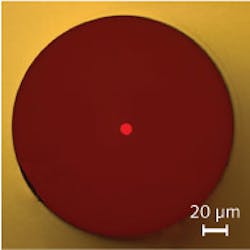Nonlinear optical fiber transmits singlemode infrared radiation

Chalcogenide glass fibers have a broader mid-infrared (mid-IR) wavelength transmission window (1.5–11 μm) and higher nonlinearities (approximately 1000 times that of silica) than any other infrared (IR) optical fibers, making them ideal for the development of mid-IR supercontinuum sources used in spectroscopy, R&D, and life-science applications.
A new chalcogenide-based, nonlinear singlemode optical fiber, the IRF-S-9 from IRflex Corporation (Danville, VA), is fabricated from arsenic sulfide (As2S3) glass with a broad transmission range from 1.5 to 6 μm and a minimum transmission loss of approximately 0.1 dB/m at 4.8 μm. Special purification techniques were used to reduce the hydrogen impurities, resulting in a narrow absorption peak of around 2 dB/m at 4.1 μm. Given its approximate 9 μm core diameter and 0.3 numerical aperture, the step-index fiber is truly singlemode for wavelengths larger than its 3.5 μm cutoff. For wavelengths shorter than the cutoff and with proper coupling, the transmitted beam could remain singlemode (or slightly multimode) over short lengths of fiber (less than 2 m) for the entire fiber transmission range. This nonlinear singlemode IR fiber is well suited for direct transmission or mid-IR supercontinuum generation. Contact Francois Chenard at [email protected].
About the Author

Gail Overton
Senior Editor (2004-2020)
Gail has more than 30 years of engineering, marketing, product management, and editorial experience in the photonics and optical communications industry. Before joining the staff at Laser Focus World in 2004, she held many product management and product marketing roles in the fiber-optics industry, most notably at Hughes (El Segundo, CA), GTE Labs (Waltham, MA), Corning (Corning, NY), Photon Kinetics (Beaverton, OR), and Newport Corporation (Irvine, CA). During her marketing career, Gail published articles in WDM Solutions and Sensors magazine and traveled internationally to conduct product and sales training. Gail received her BS degree in physics, with an emphasis in optics, from San Diego State University in San Diego, CA in May 1986.